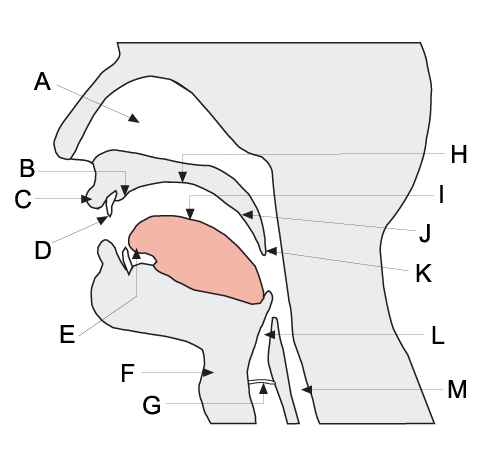|
Contoid
In articulatory phonetics, a consonant is a speech sound that is articulated with complete or partial closure of the vocal tract. Examples are and pronounced with the lips; and pronounced with the front of the tongue; and pronounced with the back of the tongue; , pronounced in the throat; , and , pronounced by forcing air through a narrow channel (fricatives); and and , which have air flowing through the nose ( nasals). Contrasting with consonants are vowels. Since the number of speech sounds in the world's languages is much greater than the number of letters in any one alphabet, linguists have devised systems such as the International Phonetic Alphabet (IPA) to assign a unique and unambiguous symbol to each attested consonant. The English alphabet has fewer consonant letters than the English language has consonant sounds, so digraphs like , , , and are used to extend the alphabet, though some letters and digraphs represent more than one consonant. For example, the ... [...More Info...] [...Related Items...] OR: [Wikipedia] [Google] [Baidu] |
Articulatory Phonetics
The field of articulatory phonetics is a subfield of phonetics that studies articulation and ways that humans produce speech. Articulatory phoneticians explain how humans produce speech sounds via the interaction of different physiological structures. Generally, articulatory phonetics is concerned with the transformation of aerodynamic energy into acoustic energy. Aerodynamic energy refers to the airflow through the vocal tract. Its potential form is air pressure; its kinetic form is the actual dynamic airflow. Acoustic energy is variation in the air pressure that can be represented as sound waves, which are then perceived by the human auditory system as sound. Respiratory sounds can be produced by expelling air from the lungs. However, to vary the sound quality in a way useful for speaking, two speech organs normally move towards each other to contact each other to create an obstruction that shapes the air in a particular fashion. The point of maximum obstruction is called the ... [...More Info...] [...Related Items...] OR: [Wikipedia] [Google] [Baidu] |
Plosive Consonant
In phonetics, a plosive, also known as an occlusive or simply a stop, is a pulmonic consonant in which the vocal tract is blocked so that all airflow ceases. The occlusion may be made with the tongue tip or blade (, ), tongue body (, ), lips (, ), or glottis (). Plosives contrast with nasals, where the vocal tract is blocked but airflow continues through the nose, as in and , and with fricatives, where partial occlusion impedes but does not block airflow in the vocal tract. Terminology The terms ''stop, occlusive,'' and ''plosive'' are often used interchangeably. Linguists who distinguish them may not agree on the distinction being made. The terms refer to different features of the consonant. "Stop" refers to the airflow that is stopped. "Occlusive" refers to the articulation, which occludes (blocks) the vocal tract. "Plosive" refers to the release burst (plosion) of the consonant. Some object to the use of "plosive" for inaudibly released stops, which may then instead be ca ... [...More Info...] [...Related Items...] OR: [Wikipedia] [Google] [Baidu] |
